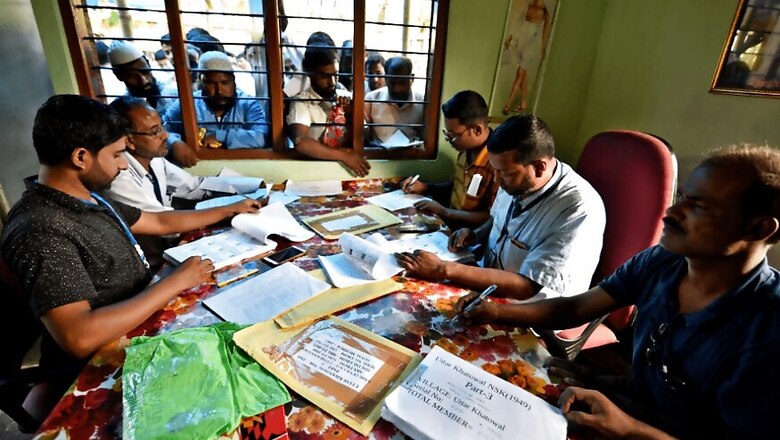
views
New Delhi: July 2019 marks the fourth year of the Supreme Court monitored National Register of Citizens (NRC) exercise, where 3.29 crore people applied to prove their citizenship. Applicants submitted in excess of six crore documents as proof for inclusion. While in two drafts NRC lists more than 2 crore “genuine” Indian citizens have been released so far, 41 lakh people have failed the test of citizenship. Of those excluded, 36 lakh have claimed for inclusion.
In the run up to the publication of final NRC draft on August 31, anxiety over citizenship has peaked in visible forms across multiple communities. More than 30 people are reported to have committed suicide.
News18 answers a few key questions around the NRC in order to understand what the exercise is.
The National Register of Citizens is a document prepared by census enumerators from the census of 1951. Under the provisions of the Census Act, the NRC was specially prepared for Assam. It still remains the only state in India to have its own Register. The 1951 NRC gave details on individuals arranged by household to understand household size and composition in Assam.
Close on the heels of the anti-illegal foreigners' movement in Assam in 1980, the All Assam Students’ Union (AASU) and Assam Gana Parishad (AGP) in 1980 had submitted a memorandum to the Centre, seeking the ‘updation’ of the list. The move was aimed at protecting the indigenous culture of Assam from illegal immigrants from Bangladesh.
In 2005, the NRC received bureaucratic approval for revision as per the guidelines of the Assam Accord of 1985. This time, however, the NRC became an instrument for determining India citizenship.
The NRC falls under the provisions of the Citizenship Act, 1955 and the Citizenship Registration Act Rules, 2003. In 2015, the process of updating records had officially started on an Rs 7 billion budget.
The Demand to Update NRC
With shifting state boundaries and, induced migration every 40 years, Assam’s geography and ethnic composition were constantly redefined against Hindu and Muslim populations of West Bengal and Bangladesh.
There were four significant changes to ‘colonial spatial order’ in Assam that is crucial to understanding why the narrative of illegal immigration on the basis of a demographic-change argument, was able to get the NRC updated.
The first being, the incorporation of Assam into Bengal Presidency in 1838. Second, the separation of Assam in 1874 from Bengal as a separate state. The Assam created in 1874 included the predominantly Bengali Muslim Sylhet district, of now Bangladesh.
The third change is the 1905 partition of Bengal into a Bengali Hindu province of West Bengal and a new predominantly Bengali Muslim province, ‘East Bengal and Assam’. This partition was annulled in 1912 and Assam was reconstituted as a separate province: the fourth change in border. The Bengali Muslim district of Sylhet and the Bengali Hindu district of Cachar was included in the Assam that was created.
When for the first time in 150 years, on Indian independence, the Assamese came to power in the state, the first instinct for action was local self-preservation, protection and promotion.
The cartographic changes to Assam in addition to illegal immigration had caused its population to rise - mostly Bengali and Muslims populations. Updating the NRC was a way to deal with the rising influx of the outsider in Assam.
How is Citizenship Ascertained in NRC?
There are two ways for registering in the NRC. First, submit one document as proof of domicile in Assam from a given list that is issued by the Government of India (GOI) before 24 March 1971. Second, establish a documented relationship or a ‘family tree’ confirming kinship network with an ancestor – by providing supporting evidence – who has a recognised document of Assam domicile issued by the GOI to his/her name before 24 March 1971. The NRC has shifted the constitutional deadline of citizenship in Assam to 24 March 1971 from 19 July 1948.
The NRC recognises these documents: 1951 NRC, electoral rolls upto 24th March 1971, passport, citizenship certificate, birth certificate, educational certificate, etc. Failing to prove the above, one would be declared a non-citizen of India.
Why is Minority Apprehensive of the NRC?
After Independence, the ‘Assamese’ saw themselves as a British project run by Bengali influence and culture. The British declaration of Bengali as the official language of Assam in schools and law courts come as facts to this case. Such Bengali favourism, and thereby ‘Assamese’ discrimination, built over centuries of English social interaction and cultural socialisation, mounted an ‘Assamese’ resentment.
In effect, in the years soon after Independence, politics in Assam took this turn: Assamese was made the official language of the state, the employment of the ‘sons of the soil’ in state administrative services became a policy initiative, ‘Assamese’ teachers were appointed in schools while Assamese was pressed as the language of instruction in educational institutions.
With the creation of Bangladesh in 1971 and the illegal immigration of Bengali Muslims from the new state, Bengali and Muslim identities came under further scrutiny as the face of illegal immigration.
It is within this historic context of identity formation, that all those whose names are not there in the draft NRC will get another chance at appealing to the NRC authorities.
But those who do not have their names in the final NRC either, will be deemed as not a citizen of the country. They will have to fight the battle in the Foreigners Tribunals to prove themselves as Indians.
What Happens to Those Who Lose Cases at Foreigners Tribunals?
The Claims and Objections phase of the NRC process allowed excluded applicants to file for inclusion. During this phase, close to 36 lakh people reapplied to prove their citizenship. Applicants were served notices by the Foreigners Tribunals and asked to attend hearings.
Neither the state nor the Centre has clarified what happens to those who lose their cases in the Foreigners’ Tribunals, whether they will be detained, deported or allowed to stay on without the rights and privileges of citizenship. So far, the focus has been to only include or exclude people in the NRC list.
With only six Detention Centres and lakhs of suspected detainees, Assam is years away from sweeping the state clean of 40 lakh NRC off-the-lists; forget deporting them without a repatriation treaty with Bangladesh - as imagined by many. The Supreme Court also paved way for setting up 200 additional foreigners’ tribunal in Assam.
The additional tribunals have to be made functional by September 1. At present, there are around 80 such tribunals functioning while the requirement, as per Assam government's own estimation, is about 1,000 tribunals.














Comments
0 comment